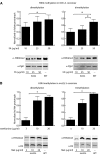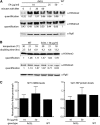Nutritional control of epigenetic processes in yeast and human cells
- PMID: 23979574
- PMCID: PMC3813867
- DOI: 10.1534/genetics.113.153981
Nutritional control of epigenetic processes in yeast and human cells
Abstract
The vitamin folate is required for methionine homeostasis in all organisms. In addition to its role in protein synthesis, methionine is the precursor to S-adenosyl-methionine (SAM), which is used in myriad cellular methylation reactions, including all histone methylation reactions. Here, we demonstrate that folate and methionine deficiency led to reduced methylation of lysine 4 of histone H3 (H3K4) in Saccharomyces cerevisiae. The effect of nutritional deficiency on H3K79 methylation was less pronounced, but was exacerbated in S. cerevisiae carrying a hypomorphic allele of Dot1, the enzyme responsible for H3K79 methylation. This result suggested a hierarchy of epigenetic modifications in terms of their susceptibility to nutritional limitations. Folate deficiency caused changes in gene transcription that mirrored the effect of complete loss of H3K4 methylation. Histone methylation was also found to respond to nutritional deficiency in the fission yeast Schizosaccharomyces pombe and in human cells in culture.
Keywords: S-adenosyl-methionine; Set1; folate; histone methylation; methionine.
Figures








Similar articles
-
Nutri-epigenomic Studies Related to Neural Tube Defects: Does Folate Affect Neural Tube Closure Via Changes in DNA Methylation?Mini Rev Med Chem. 2015;15(13):1095-102. doi: 10.2174/1389557515666150909144828. Mini Rev Med Chem. 2015. PMID: 26349489 Review.
-
Histone H3 K36 methylation is associated with transcription elongation in Schizosaccharomyces pombe.Eukaryot Cell. 2005 Aug;4(8):1446-54. doi: 10.1128/EC.4.8.1446-1454.2005. Eukaryot Cell. 2005. PMID: 16087749 Free PMC article.
-
Both H4K20 mono-methylation and H3K56 acetylation mark transcription-dependent histone turnover in fission yeast.Biochem Biophys Res Commun. 2016 Aug 5;476(4):515-521. doi: 10.1016/j.bbrc.2016.05.155. Epub 2016 Jun 3. Biochem Biophys Res Commun. 2016. PMID: 27268234
-
Neural tube defects induced by folate deficiency in mutant curly tail (Grhl3) embryos are associated with alteration in folate one-carbon metabolism but are unlikely to result from diminished methylation.Birth Defects Res A Clin Mol Teratol. 2010 Aug;88(8):612-8. doi: 10.1002/bdra.20690. Birth Defects Res A Clin Mol Teratol. 2010. PMID: 20589880 Free PMC article.
-
Mixed lineage leukemia: histone H3 lysine 4 methyltransferases from yeast to human.FEBS J. 2010 Apr;277(8):1805-21. doi: 10.1111/j.1742-4658.2010.07607.x. Epub 2010 Mar 4. FEBS J. 2010. PMID: 20236312 Free PMC article. Review.
Cited by
-
One-Carbon and Polyamine Metabolism as Cancer Therapy Targets.Biomolecules. 2022 Dec 19;12(12):1902. doi: 10.3390/biom12121902. Biomolecules. 2022. PMID: 36551330 Free PMC article. Review.
-
Metabolic programming of the epigenome: host and gut microbial metabolite interactions with host chromatin.Transl Res. 2017 Nov;189:30-50. doi: 10.1016/j.trsl.2017.08.005. Epub 2017 Sep 1. Transl Res. 2017. PMID: 28919341 Free PMC article. Review.
-
Sex-Specific Associations between One-Carbon Metabolism Indices and Posttranslational Histone Modifications in Arsenic-Exposed Bangladeshi Adults.Cancer Epidemiol Biomarkers Prev. 2017 Feb;26(2):261-269. doi: 10.1158/1055-9965.EPI-16-0202. Epub 2016 Oct 20. Cancer Epidemiol Biomarkers Prev. 2017. PMID: 27765800 Free PMC article. Clinical Trial.
-
Epi-Drugs in Heart Failure.Front Cardiovasc Med. 2022 Jul 13;9:923014. doi: 10.3389/fcvm.2022.923014. eCollection 2022. Front Cardiovasc Med. 2022. PMID: 35911511 Free PMC article. Review.
-
Metabolic control of methylation and acetylation.Curr Opin Chem Biol. 2016 Feb;30:52-60. doi: 10.1016/j.cbpa.2015.10.030. Epub 2015 Nov 28. Curr Opin Chem Biol. 2016. PMID: 26629854 Free PMC article. Review.
References
-
- Alkins S. A., Byrd J. C., Morgan S. K., Ward F. T., Weiss R. B., 1996. Anaphylactoid reactions to methotrexate. Cancer 77: 2123–2126 - PubMed
-
- Amberg D. C., Burke D., Strathern J. N., 2005. Methods in Yeast Genetics: A Cold Spring Harbor Laboratory Course Manual. Cold Spring Harbor Laboratory Press, Cold Spring Harbor, NY
-
- Aparicio O., Geisberg J. V., Sekinger E., Yang A., Moqtaderi Z., et al. , 2005. Chromatin immunoprecipitation for determining the association of proteins with specific genomic sequences in vivo, pp. 21.3.1–21.3.33 in Curr. Protoc. Mol. Biol. John Wiley & Sons, Inc., Hoboken, NJ. - PubMed
-
- Barski A., Cuddapah S., Cui K., Roh T. Y., Schones D. E., et al. , 2007. High-resolution profiling of histone methylations in the human genome. Cell 129: 823–837 - PubMed
Publication types
MeSH terms
Substances
Grants and funding
LinkOut - more resources
Full Text Sources
Other Literature Sources
Medical
Molecular Biology Databases

